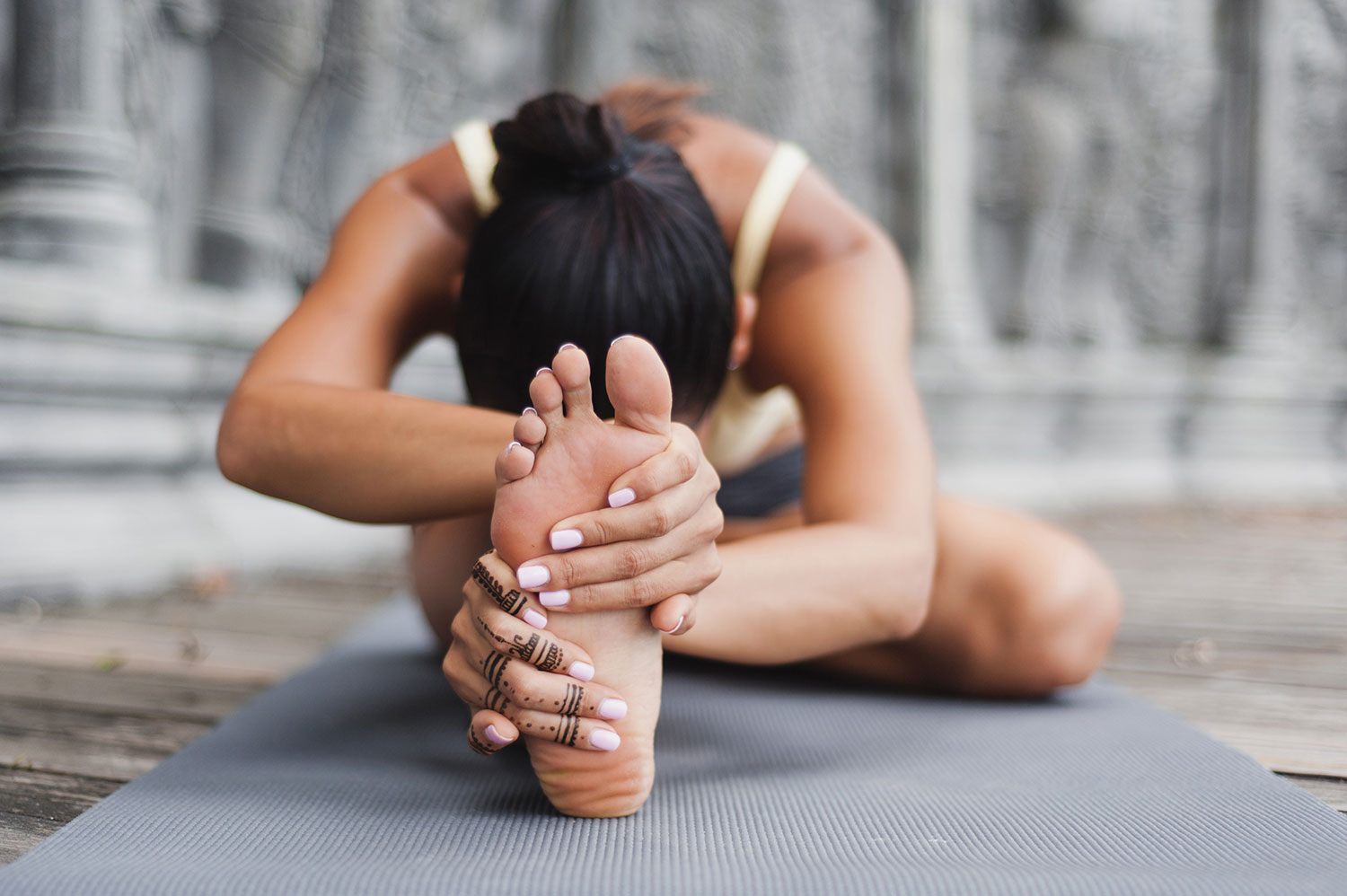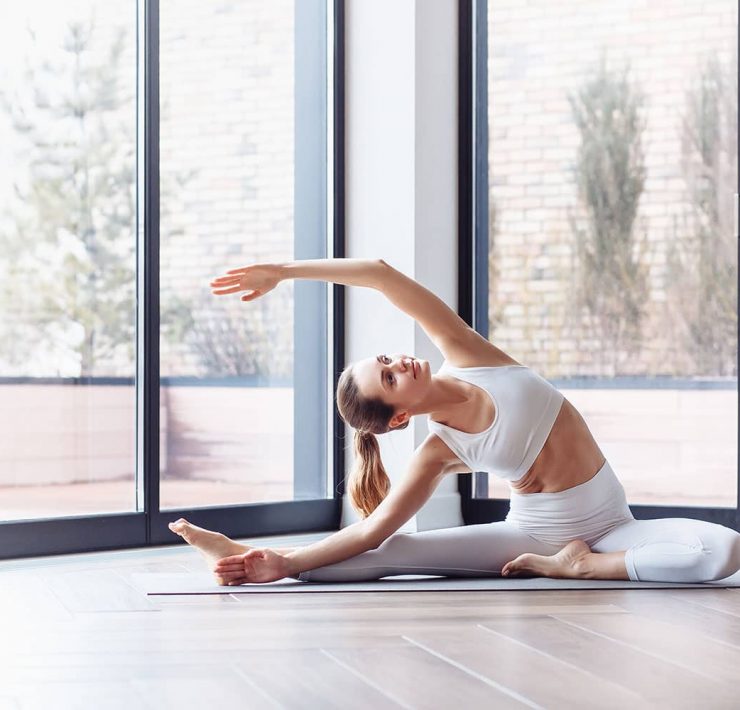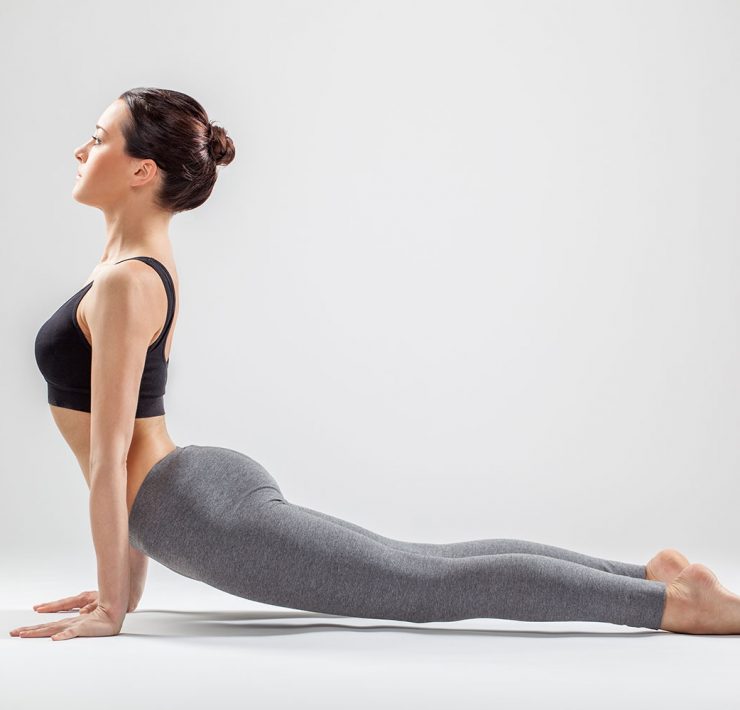
Paving the way for yogic living in Nebraska, Jacqueline Roberts…
Many of us take our feet for granted. These seemingly simple parts of our anatomy are actually quite complex structures that deserve some extra care and attention. Not only are our feet our most reliable mode of transport, they are our direct connection to earth below and stability for the whole body starts with our feet. When things go wrong, problems in the feet can make for a huge decrease in ability and quality of life for some, and can even cause pain and injuries in the hips, back, and entire spine.
One important aspect of the foot is the plantar fascia. This fascia is a long sheath of fibrous tissue that spreads along the sole of the foot, covering all the muscles, ligaments, and tendons within the complicated anatomy of the foot. It connects to the heel at the plantar aponeurosis, where the ligament continues up to connect to the muscles of the calf.
When this tissue is overused or irritated, the sole of the foot or heel can become very painful, making it difficult to walk, stand, and exercise. This results in what is known as plantar fasciitis. Some people experience it as a deep bruise or ache, and others may feel more of an inflammatory sensation.
There are many causes of plantar fasciitis, and it can unfortunately be difficult to treat for some individuals. To reverse or prevent plantar fasciitis, incorporate these yoga exercises into your daily routine.
Are You At Risk For Developing Plantar Fasciitis?

Credits amazonaws.com
While injury to the plantar fascia can happen to anyone, some people are more prone to develop issues. For instance, flat-footed individuals may have particular trouble with this as the tissue is more likely to be strained. Very high arches can also pose a problem, because this tissue will be naturally tighter.
Certain sports may increase your risk for plantar fasciitis as well. Anything that strains the feet – such as running or dancing – can lead to problems more quickly. These athletes should take special care to keep their feet healthy. Additionally, anyone who stands or walks excessively throughout the day for their job or just by habit may have trouble with plantar fasciitis.
Increases in weight can put a lot of strain on the feet as well. Whether it is typical weight gain or a pregnancy causing weight gain, the feet will have to compensate for the changes in the body.
Common Therapies for Plantar Fasciitis

If you have suffered from plantar fasciitis, you are likely familiar with some of the common exercises and therapies aimed at treating this condition. A common recommendation is to roll a frozen water bottle or a tennis ball under the foot to loosen and soothe the tissue. Epsom salt baths can also be helpful to relieve pain, as well as loosen the muscles of the leg. Some seek out help from chiropractors, acupuncturists, kinesiologists, or podiatrists. These therapies can be helpful for many, but sometimes additional help is needed.
Yoga Can Help

The best way to holistically improve plantar fasciitis symptoms is to make sure all structures in the foot are stretched and strengthened. This will prevent the fascia from getting too tight or having too much pressure on the tissue. Because yoga gently and cohesively stretches the tendons and muscles, these exercises can provide a great base treatment for plantar fasciitis.
Another important step to managing plantar fasciitis is to make sure that the tendons and muscles of the lower leg are in good shape as well. Because the plantar fascia connects to the calcaneus (the heel) and then to the calf muscles, stiffness in the lower legs can be a major culprit in plantar fasciitis. In many cases, there is not a structural issue with the foot or heel itself – it is the tightness of the gastrocnemius and soleus muscles of the leg that pull on that plantar aponeurosis and cause trouble. To relieve pain and inflammation in the plantar fascia, these muscles must be relaxed and nourished.
Yoga is an amazing way to strengthen the whole body, even the feet. There are many exercises that will help to improve plantar fasciitis or even prevent it altogether.
Foot Fascia Stretch

This is the perfect way to warm up the feet before your workout or yoga practice. If you suffer from plantar fasciitis, do this stretch first thing in the morning, and again in the evening.
While seated in a chair, cross one leg over the other so that your foot is resting on the opposite knee. Gently and slowly pull your toes back towards your shin to stretch the bottom of the foot. Hold for 15 seconds, release, then repeat three to five times.
For added benefit, while holding this stretch, massage the sole of the foot, from heel to the base of the toes with your other thumb. Use moderate pressure and rub the sole of the foot in a circular motion up towards the toes.
Mountain Pose

Simple and steady, Mountain Pose is an excellent way to gently engage the foot fascia and leg muscles, and can easily be done throughout the day during a break at work or even standing in line at the grocery store.
Stand tall with your feet together, shoulders back, neck straight, and chin tucked slightly. Hang your arms by your side, shoulders down, with palms facing in front of you. Engage your thigh muscles, lift your knee caps, and image a straight line connecting your pelvis to the top of your head. Connect to the ground beneath your feet.
If you are standing barefoot, lift your toes while maintaining a steady pose. Try to put each toe down separately starting with the pinky toes. Lift and repeat a few times. Return to a strong stable position and take a several full breaths here.
Runner’s Stretch

Commonly referred to as a Runner’s stretch, this pose will benefit anyone who spends a lot of time on their feet. Not only will this stretch give you the chance to open up the plantar fascia, but will also stretch the muscles of the calf to loosen tension along the whole lower limb chain.
From mountain pose, step one foot forward and bend into a low lunge, resting the opposite knee on the ground. Stabilize by placing the hands on the ground on each side of the front foot. Straighten the bend in the front leg, shift the hips and torso back so they are just above the back knee, and flex the foot to point to the sky. Rest here for 10-20 seconds, return to low lunge, and repeat three times. Continue on the opposite side.
Foot Stretch from Tabletop

This exercise provides a nice opening stretch to the entire foot to release pressure in the fascia.
Come to your hands and knees on the floor to find a tabletop position. Make sure hands are stable beneath the shoulders, and knees are stable beneath the hips. Curl the toes under so that the heels point up. Rest here for a few breaths.
To deepen the stretch in the fascia, send your hips back and rise to sit on your heels, keeping the toes curled under. Make sure not to stretch the feet so much that you feel pain, but enough to get the sensation of a deep stretch.
Downward dog with heel lifts

We all know downward dog is a classic yoga pose, but it can be used specifically as an exercise to stretch the plantar fascia. Downward dog is great for increasing the flexibility of the hamstrings and calves to loosen the strain on the plantar fascia. Modify this pose with heel lifts to really focus on strengthening the foot as well.
Come to the floors on hands and knees, similar to the tabletop position. With hands firmly planted and toes on the ground, stretch the knees to come to a downward dog position. Start with the knees slightly bent and heels off the ground, then exhale and slowly straighten the legs bringing the feet fully to the ground if possible.
One foot at a time, peel the heel off the ground (keeping toes on the ground) and stretch the foot. Hold for 5-10 seconds, then repeat with the opposite foot. Alternate these heel lifts 5-10 times.
Garland pose

Garland pose is a fantastic stretch for the entire lower body, including the soles of the feet. It will strengthen your stance and stretch the joints of the hips, knees, and ankles. Pay special attention to the sensation in your plantar fascia with this pose. Make sure to adapt by lifting the heels if too much pain or pressure arises.
Bend your knees to a squat, keeping the heels on the floor if possible. If you need extra support, roll up a towel to place beneath them. Place your elbows on the inside of your knees, bring your hands to anjali mudra, or prayer position, at the heart. Press outward with your elbows against the knees while pressing inwards with your knees. Rest here for 30 seconds to one minute.
Protect and Prevent With Yoga

Plantar fasciitis can be a tricky condition and can often impact the daily life of those affected. Thankfully, there are so many natural ways to help the feet and heels recover from plantar fasciitis. Rolling the feet on bars or tennis balls, stretches, and bodywork all provide a starting place to reduce pain and inflammation. Adding yoga exercises to your daily therapeutic regimen will greatly improve the state of your fascia and reduce or eradicate symptoms.
If you are looking more for a preventative approach to foot care, yoga offers a simple and quick way to take care of your feet from the beginning. Incorporate these exercises into your daily routine and your feet will be taking you places for years to come.
What's Your Reaction?
Paving the way for yogic living in Nebraska, Jacqueline Roberts is adored by her students as a constant source of support and inspiration. A knack for writing allows her to share what she has learned with the world.















Thanks for sharing these movements, I shall and will definitely add it to my sciatic stretches I do every morning and at night.
Good read and informative, learn a lot of things about the importance of yoga in treating plantar fasciitis.